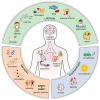Genetic, Environmental and Lifestyle Determinants of Accelerated Telomere Attrition as Contributors to Risk and Severity of Multiple Sclerosis
- PMID: 34680143
- PMCID: PMC8533505
- DOI: 10.3390/biom11101510
Genetic, Environmental and Lifestyle Determinants of Accelerated Telomere Attrition as Contributors to Risk and Severity of Multiple Sclerosis
Abstract
Telomeres are protective structures at the ends of linear chromosomes. Shortened telomere lengths (TL) are an indicator of premature biological aging and have been associated with a wide spectrum of disorders, including multiple sclerosis (MS). MS is a chronic inflammatory, demyelinating and neurodegenerative disease of the central nervous system. The exact cause of MS is still unclear. Here, we provide an overview of genetic, environmental and lifestyle factors that have been described to influence TL and to contribute to susceptibility to MS and possibly disease severity. We show that several early-life factors are linked to both reduced TL and higher risk of MS, e.g., adolescent obesity, lack of physical activity, smoking and vitamin D deficiency. This suggests that the mechanisms underlying the disease are connected to cellular aging and senescence promoted by increased inflammation and oxidative stress. Additional prospective research is needed to clearly define the extent to which lifestyle changes can slow down disease progression and prevent accelerated telomere loss in individual patients. It is also important to further elucidate the interactions between shared determinants of TL and MS. In future, cell type-specific studies and advanced TL measurement methods could help to better understand how telomeres may be causally involved in disease processes and to uncover novel opportunities for improved biomarkers and therapeutic interventions in MS.
Keywords: aging; disease modifiers; environment; genetics; lifestyle; multiple sclerosis; risk factors; telomere length; telomere shortening.
Conflict of interest statement
The authors declare no conflict of interest.
Figures

References
-
- Moyzis R.K., Buckingham J.M., Cram L.S., Dani M., Deaven L.L., Jones M.D., Meyne J., Ratliff R.L., Wu J.R. A highly conserved repetitive DNA sequence, (TTAGGG)n, present at the telomeres of human chromosomes. Proc. Natl. Acad. Sci. USA. 1988;85:6622–6626. doi: 10.1073/pnas.85.18.6622. - DOI - PMC - PubMed
Publication types
MeSH terms
LinkOut - more resources
Full Text Sources
Medical

